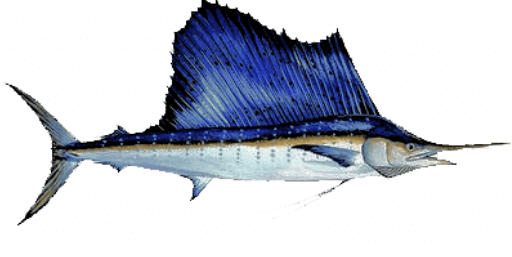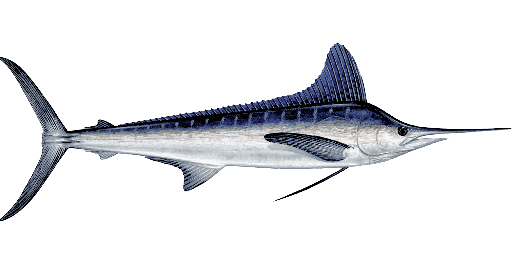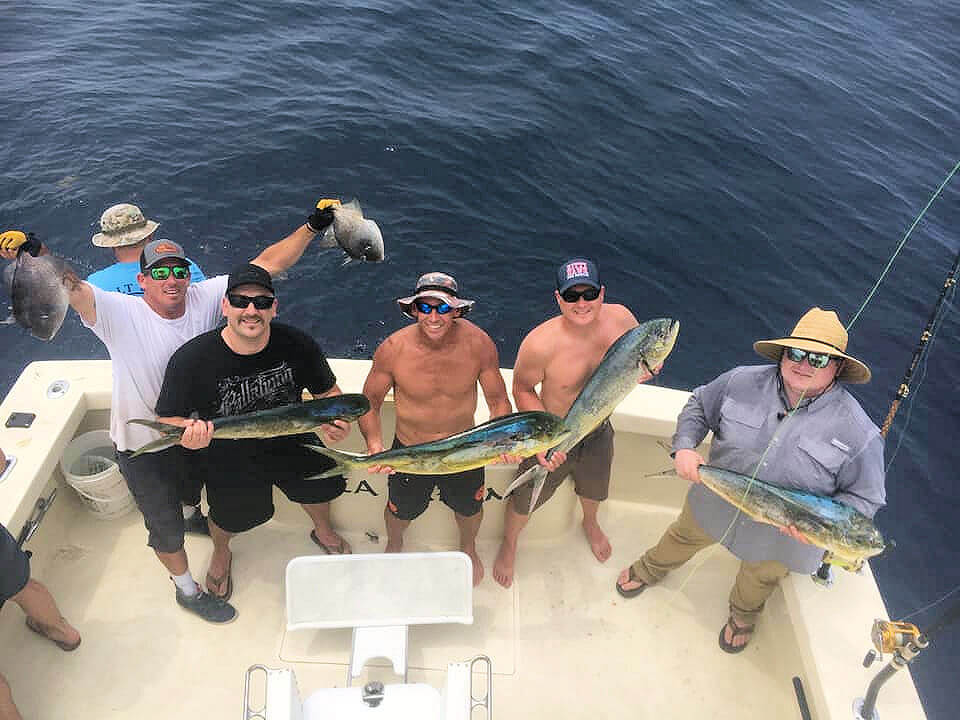Hatteras Offshore Fish Species and Seasons
Anytime that you can make it to Hatteras is a good time to fish here! Different times of the year can be better offshore for certain species but there is nearly always something available in our Hatteras offshore Gulf Stream waters for us to catch. Here is a description of some of the species that are commonly caught by Hatteras charter fishing boats.
The Atlantic Gulf Stream brings southern warm water up along the East Coast bringing with it many migrating pelagic species of fish. The Gulf Stream is like a flowing river within the ocean. Since Hatteras extends out far into the Atlantic it allows the Gulf Stream to often meander in as close as just 10 miles from the Hatteras Inlet. This is the closest the Gulf Stream comes to land at any point north of Miami. For the angler it means that when fishing out of Hatteras Inlet you will spend more time fishing and less time boat riding. Although there are hundreds of fish species in the Atlantic our Hatteras boats spend most of our time fishing offshore for mahi, wahoo, yellowfin tuna, blackfin tuna, bluefin tuna, sailfish, blue marlin, white marlin and king mackerel. Near shore we fish for bluefish, spanish mackerel and sometimes red drum and cobia in certain times of the year.
Mahi Mahi

More commonly called dolphin in North Carolina, mahi are very often the stars of the offshore charter fishing show. With an average lifespan of just five years and sometimes achieving weights of 70 pounds or more, they can grow very quickly and always seem ready to attack any bait. Smaller mahi travel in huge schools and often hang out around floating grass (sargasso weed) or debris. When they are located charter boats can quickly fill their fish boxes with these tasty fish. Larger mahi cruise the Gulf Stream in singles or pairs. Although mahi can be caught nearly any month of the year the best mahi fishing can be between the months of May and September.
Wahoo

You don't see it in this picture but wahoo are known to offshore fishermen for having a serious set of extremely sharp dentures that can cut through any fishing line, leader, lure, or anything else for that matter. Most people agree that its name probably came from those screaming long runs when a wahoo hits your bait. Although wahoo can travel in loose groups during the late summer, they are usually caught scattered and one at a time. Many offshore anglers consider the flakey white wahoo steaks to be the best eating of all offshore species. Wahoo weights can range from 20 to over 100 pounds. The best wahoo fishing is usually from June through October with peak action in late August and early September.
Yellowfin Tuna

For decades the powerful yellowfin tuna has been a highly prized catch in NC's offshore waters. Their popularity is likely because they have it all when it comes to great offshore fishing. They travel in large schools so multiple hook ups can be common. They fight like bulldogs and are often caught in weights from 30 to well over 100 pounds. Anyone that has ever eaten fresh blackened tuna steaks will tell you that "Charlie Tuna in a can" is not even in the same league with a fresh caught tuna. When all the trolling lines start screaming line off your reels at the same exact instant it's a pretty good bet that you have just trolled through a school of hungry yellowfin tuna.
Sailfish

Off our North Carolina coast this beautiful species migrates throughout the warmer waters of the Gulf Stream as well as inshore waters and is usually only caught during the hot summer months when the water temperatures are the most favorable. Although they can aggressively follow and attack lures, they also can be hard to hook on standard trolling tackle and hooks that are designed for bigger fish. However, once hooked they can put on a spectacular aerial display of dancing and shaking their massive sail. Most Atlantic Ocean sailfish will range in size from 30 pounds to 65 pounds. Best months to hook a sailfish are usually going to be in June through August and normally all sailfish are released in NC to be caught another day.
White Marlin

Whatever white marlin might be lacking in size when they are compared to the blue marlin, they make up in excitement and fun. This billfish species often travels in schools and multiple hook ups are common. When white marlin are active in an area Hatteras charter boats often will employ specifically deigned lighter tackle in order to have a better opportunity to hook them. Hook up ratios can be tough and many feel like one hooked fish for every 4 strikes will be a pretty good ratio. The average weight varies from 40 to 80 pounds and this is another species that is normally released. Your best times to catch a white marlin are May through September with July usually being the peak month off Hatteras.
Blue Marlin

This species is "king of its domain"! Anyone that has ever had the opportunity to even view this beautiful fish close up will realize that it is easily the majestic ruler of all sportfishing. Long powerful runs with awesome sky touching leaps will highlight the scene for anyone lucky enough to hook up a blue marlin. Averaging in weight from 200 pounds up to 1000 pounds these spectacular fish are considered to be the ultimate in sportfishing excitement. Just releasing one of these beautiful fish after a long grueling battle is one of the most rewarding fishing experiences to be accomplished anywhere. Although a blue marlin might show up at any time the best months are normally June through August.

